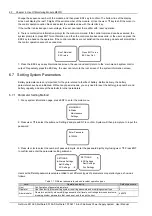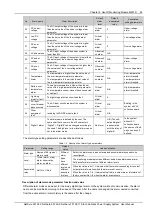
Chapter 6 Use Of Monitoring Module M501D 99
Table 1.4 Description of battery test parameters
Parameter
Setting
range
Default value
Value description
Test end voltage
43.1V
to
57.9V
45.2V
The monitoring module can do battery test, and record 10 sets of test data
(accessible only through the host). The battery test has to be started
manually, then monitoring module will control the rectifier output voltage,
make it lower than the battery voltage, and the battery discharge will
begin. Monitoring module will stop the test if the battery voltage reaches
the ‘Battery test voltage’, or the discharge time reaches ‘Battery test time’,
or the battery capacity reaches ‘Test End Cap’. Afterwards, it will restore
the rectifier output voltage to the normal FC voltage, begin the battery
charge and switch the system to battery auto-management. Meanwhile
the test start time/voltage and end time/voltage and battery remaining
capacity will be recorded. The records can be queried through the host.
During the battery test, if abnormalities occur, the monitoring module will
stop the battery test automatically
Test end time
5 to 1440
minutes
300 minutes
Test end capacity
0.01C
10
to
0.95C
10
0.7C
10
Timing test enabled
Yes, No
Yes
When the parameter ‘Scheduled Test’ is set to ‘Y’, the monitoring module
will test the battery according to the 4 sets of test time. You can set at
most 12 sets of test time through the host
Timing test time 1
Month, day,
hour
24:00 on
January 1
Timing test time 2
24:00 on April
1
Timing test time 3
24:00 on July 1
Planed test time 4
24:00 on
October 1
Fast test alarm
1 to
100A
10A
If the battery have not discharged within the ‘ShortTest Cycle’, the
monitoring module will start a short test, whose operation time is set by
the parameter ‘ShortTest Duration’. By the end of the test, if the difference
in the discharge currents of batteries is bigger than the ‘Alarm Current’,
the battery discharge imbalance alarm will be raised. This alarm will
automatically end after 5min of delay. Also you can end it by confirming it
Fast test period
24 to 8760
hours
720 hours
Fast test time
1 to 60
minutes
5 minutes
Constant current
test enabled
Yes, No
The stable test is conducted with constant battery current, whose value is
set through the parameter ‘StableTest Current’. If the parameter
‘StableTest Enable’ is set to ‘Y’, and the test will be started once the
battery satisfies the test condition
Constant current
test current
0 to 9999A
9999A
Temperature compensation coefficient setting
The root screen of the setting interface is as follows:
Temp. 1:
None
Temp. 2:
None
If the ‘Temperature1’ or ‘Temperature2’ is set to ‘Battery Temp’, you need to set the following parameters:
Center Temp:
25 C
Temp Comp Coeff
70mV/ C/Str
°
°
Batt. Temp Alarm
Bat.Over: 50 C
Bat. High: 50 C
Bat.Low: 0 C
°
°
°
When conducting setting, use ▼ or ▲ key to select one of screens or parameter items to be set, and ◄ or ► to
select the parameter value. Then press ENT key to confirm and save.
The value of temperature compensation coefficient is described as follows:
Table 1.5 Description of temperature compensation coefficient
Parameter
Setting
range
Default value
Value description
Temperature 1
N/A,
battery
temperatur
e, ambient
temperatur
e
N/A
The ‘Ambient Temp’ and ‘Battery Temp’ refer to the
measurement of the ambient or battery temperature sensor at
the local power system. ‘None’ means there is no measurement
input. You should set this parameter according to the actual
situation. The temperature measurement data will be displayed
in the system operation information screen
Temperature 2
NetSure 501 A50, NetSure 501 AA0, NetSure 701 A51 19-Inch Subrack Power Supply System User Manual
















































